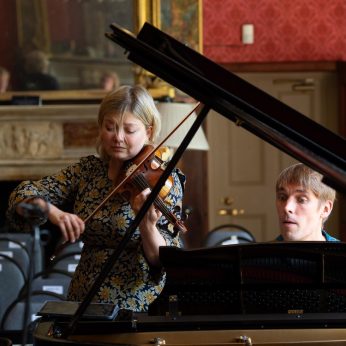Composer: Robert Schumann (b. 1810 - d. 1856)
Performance date: 23/06/2023
Venue: Bantry House
Composition Year: 1851
Duration: 00:33:42
Recording Engineer: Tom Norton, RTÉ
Instrumentation: vn, pf
Instrumentation Category:Duo
Artists:
Alina Ibragimova -
[violin]
Cédric Tiberghien -
[piano]

Second Grand Sonata for violin and piano in D minor Op.121 [1851]
1. Ziemlich langsam – lebhaft
2. Sehr lebhaft
3. Leise, einfach
4. Bewegt
By 1850, when Schumann moved to Düsseldorf as their municipal Music Director, he was considered by many to be Germany’s greatest living composer. Schumann was not a success as a conductor but in the next three and a half years he hardly seemed to stop composing. His style had moved a long way from the miraculous youthful piano works, that unstoppable flow of ideas that seemed to trip up over each other in their desire to reach the page had been replaced by a more serious muse, who could replace unceasing invention with masterly structures and a sure grasp of form.
The six fierce opening chords indicate immediately that this work will be built on a massive scale. The seemingly directionless introduction already anticipates the movement’s main theme. One of the refreshing things about Schumann’s early music had been to drop hackneyed accompaniment figures and to replace them with novel, expressive patterns. In his later work these patterns take on constructive significance, so the piano accompaniment to the main theme finds its way to the foreground in the transition section and then gets taken up in an augmented disguise in the cantabile second subject. This subtle device supports the overwhelming impression of a driving rhythmic impulse controlling the whole movement. This relentless pace is given even greater impetus in the Scherzo, which hardly relaxes for the two Trios, only the coda gives a brief glimpse of an alternative vision.
This is finally given to us by the magically gentle pizzicato opening to the slow movement. The hushed moment when the violinist takes up her bow again redoubles the aura of enchantment, which is curiously made all the stronger when the Scherzo’s driving rhythm tries to batter its way into this movement, crude assaults that are swiftly stilled by the violin. At the end the piano again recalls this idea but only in a half-hearted manner and is quickly hushed into silence. The finale returns undaunted to the aggressive mood of the first two movements in an almost monothematic moto perpetuo that rushes ahead without a pause for a backward glance. And so Schumann builds relentlessly to a powerful and unforgiving conclusion.
Francis Humphrys
Copyright © 2025 West Cork Music. All rights reserved.
Designed and developed by Matrix Internet